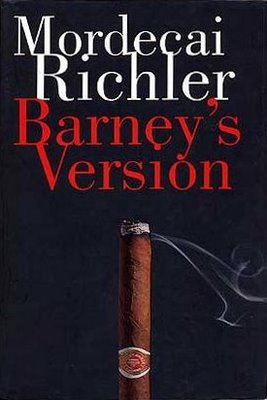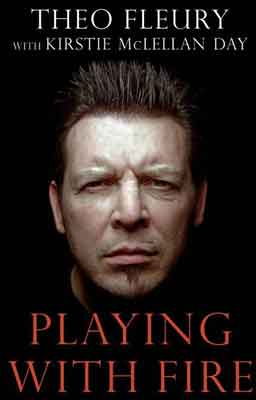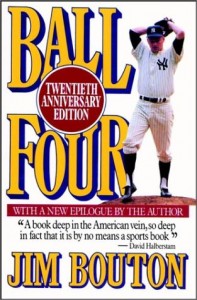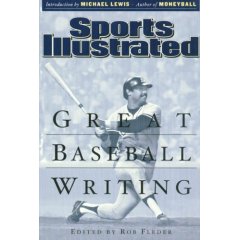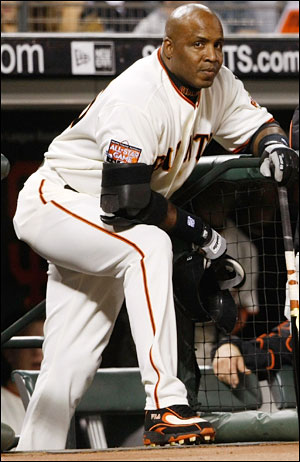Book review – The Way of Baseball
As I've alluded to once or twice, I used to work for the World's Biggest Bookstore in downtown Toronto, a part of the Chapters-Indigo chain.
About the same time I moved on to being a professional writer many of my coworkers at the WBB also moved on to bigger and better things, including my manager Justin Sorbara-Hosker, who now works for Indigo's online department.
A couple of weeks ago Justin and the staff at Simon and Schuster were kind enough to forward me a copy of Shawn Green's new book "The Way of Baseball" which I reviewed for Indigo's blog.
Below is my introduction, followed by a link to the rest of the article.
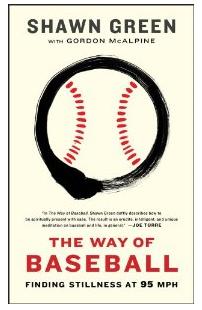 Shawn Green's The Way of Baseball has a concept so simple it's amazing no one has done it before—it uses hitting a baseball as an evolving metaphor that can be applied to everyday life.
Shawn Green's The Way of Baseball has a concept so simple it's amazing no one has done it before—it uses hitting a baseball as an evolving metaphor that can be applied to everyday life.
Green draws on his career as a right-fielder with the Toronto Blue Jays, Los Angeles Dodgers, Arizona Diamondbacks and New York Mets and examines how he used batting practice as a method of finding peace and balance in his day-to-day life.
The book is broken into nine chapters titled “Stillness,” “Space and Separation,” “Awareness,” “Ego,” “Presence,” “The Zone,” “Nonattachment,” “Gratitude,” and “Epilogue”. Each section details a step in Green’s personal journey as he develops stillness and awareness at the plate and in his interactions with teammates, coaches and fans.
Happy anniversary, Johnchidleyhill.com!
Last Tuesday was the one-year anniversary of this blog's creation. For the past year this website has been a place to work on my writing, talk about things that interest me and show off my various professional projects.
I’ve been really pleased with this site and with how my career has developed over the past year. In particular, I’ve been touched by all the positive feedback I’ve received from people. I’m always surprised with how often friends or family mention that they love my writing here. It’s nice to see my hard work appreciated like that.
To me, the most incredible thing about this blog is all the people who’ve read my posts that I don’t know personally. According to my metrics, I’ve had 16,688 unique visits and counting. When I started this site a year ago I never thought I’d have that many visitors.
Thank you for all your support.
To celebrate this blog’s anniversary I thought I’d list the top five most popular articles on this website.
But before I do, I want to mention two in particular: "Bill Simmons’ Twitter idea might be a game-changer" and "Sandwich Review: KFC’s Double Down". These two posts are the two biggest spikes in readership I’ve had over the course of the year. In both cases my readership doubled or even tripled the day they were posted.
Here are the top five most read articles of JCH.com over the past 365 days, in ascending order:
5. "Bill Simmons’ Twitter idea might be a game-changer" – May 14th, 2010
As mentioned above, this article was one of the first big spikes in traffic this blog saw. Collecting a total of 202 unique page views since it was first published, this was my first serious stab at discussing the evolving role of media in sports.
“An interesting experiment occurred on Thursday night as the Boston Celtics eliminated the Cleveland Cavaliers from the National Basketball Association’s Eastern Conference semifinal with a 94-85 victory.
As league MVP LeBron James stepped up to the free throw line in the second half the Boston crowd began to chant “New-York-Knicks! New-York-Knicks!”, referring to one of the more moribund destinations that the soon-to-be free agent might head to in the offseason.
Later, the Celtic faithful began to chant “MSG! MSG!”, the acronym for Madison Square Gardens, the home of the Knicks.
This was all part of a grand scheme concocted by ESPN.com’s Bill Simmons, Boston’s most famous sports fan, and it may just revolutionize spectatordom.”
4. "Sandwich Review: KFC’s Double Down" – Oct. 19th 2010
I’ve reviewed a lot of things on this blog: comics, books, the occasional movie and even some baseball stadiums. But my look at the controversial Double Down sandwich at KFC was the first and last crack at being a foodie you’ll ever seen in this space. That review was particularly timely, earning some buzz and a spike in readership, eventually tallying 214 reads.
“It took months to make it possible, but yesterday I finally ate a Double Down from KFC.
Normally, reviewing a sandwich is not my bag. After all, my good friend and neighbour John already does a bang-up job over at In Search of a Sandwich. Why would I want to compete?
But the Double Down - KFC’s bacon, sauce and cheese sandwich that substitutes the bread for pieces of deep-fried chicken - transcends a normal sandwich. Just as the Double Down pushes the envelope of sandwich technology, I must expand my blogging horizons for this fast food delicacy.”
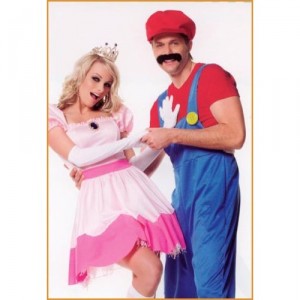 3. "Three ice dancing performances I’d like to see" – Feb. 23rd 2010
3. "Three ice dancing performances I’d like to see" – Feb. 23rd 2010
I blogged throughout the Vancouver Olympics, usually in response to a significant event at the games. By far, the most popular of these pieces was my suggestion for three ice dancing routines that would set the performers apart from the cliché-laden pack.
When I posted this link on Twitter it was quickly picked up and retweeted by many of my friends, making it as close to viral as this site has ever been. That buzz resulted in a total of 313 views to date.
Oddly, and somewhat creepily, “Princess Peach” is by far the most popular search on this website, all thanks to this article.
“Like many Canadians, I was thrilled by Tessa Virtue and Scott Moir’s gold medal ice dance performance on Monday night.
I would never call myself a figure skating or ice dancing fan – I find that too often the judge’s decisions are political – but I was impressed with the athleticism and technique of all the dancers in the competition.
What did not impress me was their lack of creativity or originality. Most of the performances bled together. Virtue and Moir stood above the rest of the competition because they didn’t rely on clichéd music like the themes from the Phantom of the Opera or Requiem for a Dream. They weren’t covered with sequins and feathers. Their performance truly distinguished them from the rest of the pack.”
2. "Toronto has two strikes against it for most professional athletes" – Mar. 9th 2010
I wrote this piece between Roy Halladay’s departure to the Philadelphia Phillies and the National Basketball Association’s free agency period that saw Chris Bosh take his talents to South Beach.
It’s a topic I’d like to revisit sometime, especially since one of my commenters pointed out that my math on the differences in taxes between the United States and Canada might be wrong. Despite the possible error, this post has been read 417 times.
“This summer could be particularly heart-breaking for fans of the Toronto Raptors as they face the prospect of forward Chris Bosh, arguably the best player the team has ever seen, leaving the city as a free agent.
Toronto Blue Jays fans can sympathize with their basketball neighbours – this summer they lost ace Roy Halladay in a lopsided trade with the Philadelphia Phillies and Seattle Mariners.
It’s a familiar story for Torontonians. One of their teams will draft a player who becomes a star, but the franchise player eventually begins to grumble and complain about greener pastures, eventually demanding a trade or letting their contract expire and moving on via free agency.”
1. "Book Review: The Glass Castle by Jeannette Wells" – Sept. 15th 2010
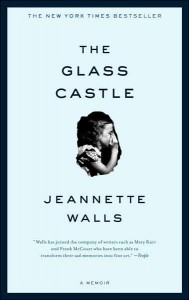 I try to review every book that I read, even if it doesn’t have anything to do with the general themes of this blog like sports and pop culture. But the incredible success of my review of the Glass Castle shows that maybe, just maybe, I should review literally every single thing I experience. Not just books, but music, food, furniture, public transportation, whatever. Although it is the second-most recent post on this list, it’s garnered far and away the most views at 1,106 and counting.
I try to review every book that I read, even if it doesn’t have anything to do with the general themes of this blog like sports and pop culture. But the incredible success of my review of the Glass Castle shows that maybe, just maybe, I should review literally every single thing I experience. Not just books, but music, food, furniture, public transportation, whatever. Although it is the second-most recent post on this list, it’s garnered far and away the most views at 1,106 and counting.
“I never thought that I’d enjoy Jeannette Walls’ "the Glass Castle", but I was wrong.
On the surface, it looked like it was more for stay-at-home moms. It was one of Heather’s Picks at Chapters-Indigo Bookstores and reeked of Oprah’s Book Club. But once I started reading it I appreciated Walls’ writing and was moved by her story.
Like Frank McCourt’s ultra-popular Angela’s Ashes, the Glass Castle is a dark memoir about a dysfunctional family crippled by the father’s alcoholism and the mother’s loose grip on reality.”
Book Review – The Book of Basketball
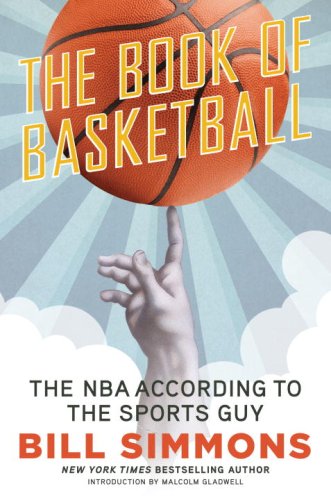 The Book of Basketball seemed like the perfect book for me, a natural fit.
The Book of Basketball seemed like the perfect book for me, a natural fit.
But Bill Simmons’ magnum opus, although entertaining and somewhat informative, fell short of my expectations.
You see, like most Canadians, I don’t know a lot about basketball. Sure, I watch maybe a game per week, I know the big name players and I certainly respect their athleticism and the skill necessary to play in the National Basketball Association.
But that level of interest pales in comparison to my obsession with hockey. That’s just the sad truth: In Canada, basketball always plays second fiddle to hockey. From an early age we’re all ingrained with an understanding of hockey that fuels our fascination.
It’s hard for any sport, especially one that runs at roughly the same time as the National Hockey League, to gain any kind of popular traction amongst Canadians.
What it boils down to for me is this: if you gave me a TV with only two channels, one broadcasting the classic 1986 NBA Finals with Magic Johnson’s Los Angeles Lakers facing Larry Bird’s Boston Celtics and the other showing a pre-2004 lockout game between the New Jersey Devils and Minnesota Wild, I’d probably end up watching the hockey.
However, I’m always trying to broaden my horizons, especially when it comes to sports and writing, and so I want to expand my basketball knowledge base.
Further, Simmons has always impressed me as an imaginative writer who can inform and amuse. Anyone who’s read his blog or followed him on Twitter knows he has a deep and abiding passion for basketball, so it seemed like reading his tome would be the perfect way to familiarize myself with the game.
There’s no denying that I learned a lot from Simmons’ 736 page treatise on every imaginable detail of professional basketball. His meticulously researched book does a lot to explain the evolving styles of play as well as the different personalities that have made up the NBA and American Basketball Association.
His lengthy footnotes and parenthetical asides made me laugh out loud and his pop-culture references are always on point. He’s got a gift for keeping sections that would otherwise be deathly boring fun and fresh. Unfortunately, they also add about an extra 100 pages to an already lengthy book.
That’s just one symptom of this book’s fatal flaw: it is poorly edited. Simmons should’ve been reined in to try and keep the book and more manageable length.
Further, a more consistent naming protocol should have been used. Player’s first names, last names and nicknames are used interchangeably from paragraph to paragraph, sometimes sentence to sentence. Although it can lead to some echoes in the writing, sticking to a standard would have lowered the word count - and in a book this big that could end up cutting some pages – and would have made the book more accessible.
This is where the book ultimately failed me.
As a survey of the history and players of professional basketball, the Book of Basketball seemed like the ideal entryway for a novice fan trying to learn about the sport. But it seems as though Simmons never really decided who his target audience was going to be, and so his narrative swings from being explanatory and appropriate for the new fan, to detailed and filled with in jokes only a long-time NBA fan would get.
Writing a book for the sophisticated fan is fine, but it should be advertised as such and be consistent in its level of accessibility. Unfortunately, the Book of Basketball is all over the map in comprehension, making it a frustrating read.
Bill Simmons’ Book of Basketball is funny and smart, but could’ve used a more firm editorial hand to rein in some of the author’s lengthier footnotes and asides to make a slightly more concise book that is accessible for all readers.
My Top 10 Essential Sports Books
My friend Justin asked me to write a blog post of my top 10 essential sports books, and, well, who am I to deny my faithful readers?
Justin didn’t give me much of an outline beyond the fact that they should be non-fiction and that they’re books that would be essential for starting anyone looking to start a personal sports library.
I decided to interpret “essential” as a book that is timeless, has a broad scope that makes it accessible and, of course, features strong writing.
Variety was also a watchword when I put this together. When it comes to writing not all sports are created equal – coming up with a list of 10 baseball books is a snap, while naming even five essential hockey books can be tricky.
However, I did manage to get a decent spread of sports. Baseball, hockey, soccer, football, professional wrestling and other combat sports are all well represented.
I should also add that this list is designed to be taken as a whole. Many of these books are meant to dovetail with each other, provide contrast or compliment other entries.
They don’t need to be read in any particular order and none of them stand out as the best of the lot. But taken altogether all ten fit together nicely, giving the reader a reasonably broad understanding of sports and athletics, even if some specific sports are left out.
Of course, I’ll also point out that I’ve read all of these books (titles that have a link will take you to my earlier, full reviews of the book). Since I haven’t read every sports book ever there are, I’m sure, some gaps in my selections.
Now, in no particular order of preference:
The grand daddy of ‘em all, Ball Four is Jim Bouton’s memoir of a year as a major league pitcher with the Seattle Pilots and later the Houston Astros. This book is the first real, hard-hitting look at the world of baseball – or any sport for that matter. Incendiary when it was released in 1969, Bouton’s book remains funny and insightful. Context will help you enjoy it, but 75% of the book can stand on its own. Admitedly, some of its power has been lost to time, but definitely worth reading, particularly the sections on some of Bouton’s more famous colleagues like Mickey Mantle and Ted Williams.
Bullpen Gospels by Dirk Hayhurst
Another relief pitcher’s memoirs, Bullpen Gospels comes from a more sincere and self-deprecating perspective. Dirk Hayhurst’s book on his year in the San Diego Padres’ minor league system is less about baseball and more about finding himself and trying to make some sense of the mess that is his life. Bullpen Gospels’ introspective narrative gives the reader a glimpse inside the surprisingly fragile psyche of a professional athlete and stands in contrast with Bouton’s groundbreaking work. It’s amazing to see how things have changed in the 50 years between the two memoirs. That said, some things never change – like baseball players womanizing ways.
Living on the Black by John Feinstein
My third pick also features professional baseball pitchers, but manages to be completely different from the earlier entries. John Feinstein’s tome (it’s a hefty 508 pages) follows the 2007 seasons of soft-tossers Tom Glavine and Mike Mussina. Living on the Black discusses the history of the players association and explains the ongoing evolution of the pitcher. Reading this book gave me a much stronger understanding of the importance of every pitch and every at bat of baseball. This book comes as close to explaining the art of big league pitching as anyone can without actually suiting up.
Searching for Bobby Orr by Stephen Brunt
Stephen Brunt’s biography of Bobby Orr – certainly the best defenceman of all time, and arguably the best hockey player ever – is marked by the fact that it was totally unauthorized. The seasoned Globe and Mail columnist had to dig deep for years to find anyone willing to speak to him about the very private Orr. All that hard work paid off as Brunt paints a rich portrait of a complicated man who revolutionized the sport of hockey on and off the ice. Searching for Bobby Orr is worth reading if just to be immersed in Brunt’s breathless description of Orr’s trademark end-to-end rushes. A must read for understanding the modern National Hockey League.
Hitman by Bret Hart
Although professional wrestling isn’t really a sport, there’s no denying the athleticism of the performers. Bret Hart’s upbringing as the most prominent member of the Hart family of wrestlers puts him in a unique position to describe the crazy lifestyle of the World Wrestling Federation. At the same time, Hart’s incredibly violent home life, coupled with his constant marital infidelity is engrossing and makes this the grittiest of all the entries on this list. This autobiography is, in a word, jarring. There is no book that is so open and honest about the sex and violence that pervades the lives of professional athletes.
 A Fighter’s Heart by Sam Sheridan
A Fighter’s Heart by Sam Sheridan
The only sport that comes close to baseball’s massive catalogue of books is boxing. Unfortunately, the sweet science is only one corner of the world of combat sport. Therefore, I chose Sam Sheridan’s survey of all sports where athletes fight – from boxing to Brazilian Jiu Jitsiu to mixed martial arts and, yes, even cock fighting – to try and encompass one of the more literary sports. Sheridan tries valiantly to understand the role that organized combat has in society and what it is about prizefighting that attracts competitors and spectators alike. An intersting and thought-provoking read that provides insight into the fringes of professional sport.
How Soccer Explains the World by Franklin Foer
Like A Fighter’s Heart, Franklin Foer’s How Soccer Explains the World tries to figure out the role of sport in a greater socio-political context. Foer’s theories are a little over-simplistic and he’s not without his biases, but nonetheless it’s an excellent book that successfully draws connections between political movements, sectarianism and nationhood with soccer teams around the world. An excellent sports book for the non-fan, and enjoyable and informative for anyone who believes that sport is an integral part of society.
Friday Night Lights by Buzz Bissinger
You’ve probably seen the movie or the TV show, but as good as they are, they just don’t do justice to Buzz Bissinger’s original examination of high school football in the oil town of Odessa, Texas. Although he doesn’t draw conclusions like Sheridan or Foer, Bissinger goes into greater depth than the other two books. Dark, sure, but Friday Night Lights does an incredible job of showing, at least on a small scale, how important sports can be to a community. By the final chapter you might not feel like a Permian Panther, but you’ll definitely sympathize with these young men.
Moneyball by Michael Lewis
Possibly the most influential book on this list, Michael Lewis’ Moneyball is often misunderstood as being a kind of baseball strategy guide. Really, it’s all about Oakland Athletics’ general manager Billy Beane squeezing the potential out of undervalued properties – in this case, baseball players. It’s a philosophy that goes well beyond the world of baseball, and the book’s become popular in many business circles. There’s lots to learn from Lewis’ most popular book: the intricacies of baseball trades, the importance of walks and the rigidity of old school baseball. Stay ahead of the curve by picking it up before Brad Pitts’ film adaptation comes out.
Fever Pitch by Nick Hornby
Speaking of books being ruined by movie adaptations – please ignore the romantic comedy starring Jimmy Fallon and Drew Barrymore loosely based off of Nick Hornby’s Fever Pitch. It’s barely related to the original. Few books capture the agony of cheering for a team that just never gets it together. You can sustitute any number of clubs for Hornby’s Arsenal. The Chicago Cubs, Detroit Lions and Toronto Maples Leafs will all do fine. This is what fandom is all about: not the highs of winning a championship but the agonizing lows where every bounce goes for the other side, where every home game gets rained on and every draft pick is a bust. Hornby captures that pain perfectly.
Book Review – The Glass Castle by Jeannette Walls
 I never thought that I’d enjoy Jeannette Walls’ the Glass Castle, but I was wrong.
I never thought that I’d enjoy Jeannette Walls’ the Glass Castle, but I was wrong.
On the surface, it looked like it was more for stay-at-home moms. It was one of Heather’s Picks at Chapters-Indigo Bookstores and reeked of Oprah’s Book Club. But once I started reading it I appreciated Walls’ writing and was moved by her story.
Like Frank McCourt’s ultra-popular Angela’s Ashes, the Glass Castle is a dark memoir about a dysfunctional family crippled by the father’s alcoholism and the mother’s loose grip on reality.
The Glass Castle also follows a very similar format to Angela’s Ashes with each short chapter detailing an episode from the childhood of the author. More often than not these are horrible snapshots of poverty or struggle as the Walls’ household disintegrates.
These grim anecdotes are broken up by some funny stories from Jeannette’s childhood and the reader is buoyed up by the loyalty of her three siblings as they try to support each other and overcome their parents’ shoddy upbringing.
Walls’ writing is very good and although the subject matter is depressing and unsettling, she wisely injects some humour to create some balance.
What interested me the most was the social dynamics within the Walls household. Jeannette and her three siblings all independently come to the conclusion that their parents are unfit to raise them and that they need to take matters into their own hands.
Writing a compelling memoir is difficult. I’ve read many autobiographies that tell the author’s life story chronologically and from a single perspective. That’s a totally fair and natural way to structure a narrative, especially since an omniscient narrator would be some trick, but it’s obviously also quite limiting.
But Walls – a long-time journalist and former blogger with MSNBC.com – does well to flesh out the “characters” of her family and imply the feelings and motivations of each relative. This adds depth to her story that most autobiographies lack. The way her parents and sibling handles each situation is unquestionably real.
Walls is also a reasonably fair and balanced narrator. Her family might not be thrilled with their personal histories being exposed, but it’d be hard for any member of the Walls clan to say that Jeannette did them a disservice. She lets their actions speak for themselves and rarely puts words in their mouths.
Normally I would dismiss the Glass Castle out of hand. But Walls’ incredible storytelling abilities and the devastating circumstances of her childhood make this memoir a must-read for any fan of literature.
Book Review: the Imperfectionists by Tom Rachman
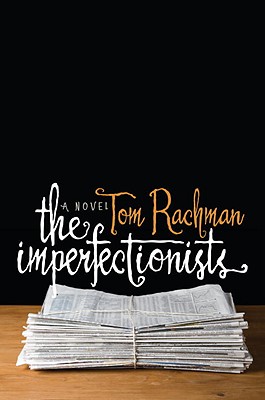 As much as I love reading, it’s rare that a book leaves me breathless. Tom Rachman’s the Imperfectionists does just that, over and over again.
As much as I love reading, it’s rare that a book leaves me breathless. Tom Rachman’s the Imperfectionists does just that, over and over again.
Rachman is a London-born journalist who has worked all over the world and he chose a familiar subject for his debut novel – the newsroom of an English-language paper in Rome.
Each chapter revolves around a different staff member or reader, with many of their stories intersecting and building on previous episodes. At every interval there is a short story about the history of the paper, colouring in some of the background of the main storyline.
It’s a masterful plot structure, deftly done, especially for a first-time novelist. The way the disparate characters and storylines intertwine and relate shows how skilled Rachman is as a storyteller.
The book had been recommended to me by my fiancé, who knew it’s tales of deadline drama in a newsroom would appeal to me, and she was spot on. Although Rachman never stoops as low as cliché or caricature, many of the characters rang true.
All of the characters are sketched out with a deft touch rarely seen in even the best authors, let alone by a first-timer. Rachman’s cast are remarkably realistic and likeable, creating sympathy for the characters and disappointment when things inevitably turn sour for the protagonists.
That’s really my one complaint about the Imperfectionists – it’s unrelentingly depressing. No good deed goes unpunished in Rachman’s world. Characters are craven and selfish. Infidelity is common with everyone ending up alone. Even success comes at a great cost in this world.
Half-way through I was dying for at least one good thing to happen to a character. Some sort of ray of hope, one chance at redemption. Anything! I was desperate for a lifeline, but it never came.
No, Rachman never gives up on his dark outlook, with the final chapter being one of the most heartbreaking.
Despite that, the Imperfectionists is an excellent read that will impress you with its complex structure. Although I was introduced to it because of my occupation as a journalist, I think this book would appeal to anyone. Definitely worth checking out.
Book Review: Bullpen Gospels by Dirk Hayhurst
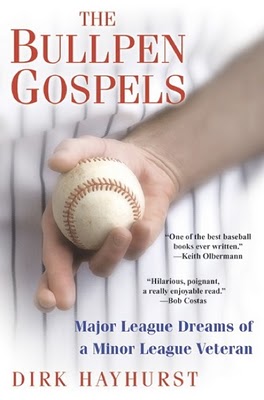 Halfway through Dirk Hayhurst’s Bullpen Gospels it occurred to me that I was reading one of the best books on baseball, ever.
Halfway through Dirk Hayhurst’s Bullpen Gospels it occurred to me that I was reading one of the best books on baseball, ever.
That’s some strong talk, particularly for someone who hasn’t read the entire baseball canon. But I’m getting there - just about every other book I read is about baseball.
I’ve devoured Jim Bouton’s Ball Four more than five times, I loved John Feinstein’s Living on the Black and Michael Lewis’ Moneyball. Also, as fans of this blog know, I’ve reviewed the graphic novel Satchel Paige:Striking Out Jim Crow as well as Sports Illustrated’s Great Baseball Writing.
The Bullpen Gospels slot in right above all of those, including Ball Four, my previous titleholder.
They’re comparable books too. Both are written by professional baseball players who find themselves pitching long relief in a bullpen full of odd characters. Yes, Bouton was an established major leaguer trying to master the knuckleball while Hayhurst, at that point, was a career minor leaguer in the San Diego Padres organization, but they’re still pretty similar books.
Bouton’s book is infamous for exposing the real lives of baseball heroes like Carl Yastrzemski and Mickey Mantle at a time when they were idolized by most fans. The aging Seattle Pilots reliever took a lot of heat for the book, with many people saying Bouton was a gloryhound. I don’t agree with that sentiment, but it certainly reads like an expose.
Love it or hate it, Ball Four is a hilarious and insightful read. But, by contrast, the Bullpen Gospels is a much more genuine and sensitive story.
Starting with Hayhurst’s truly dire home life with an unbalanced grandmother and a fractured family crippled not by one, but two, alcoholics you immediately feel for the young reliever. When he moves on to spring training and the minor leagues you can’t help but appreciate his sense of humour.
Perhaps the most noticeable difference between Hayhurst and Bouton is that the former rarely criticizes his teammates or the Padres’ executives. On the few occasions when he does speak poorly of someone, it is a reasonable and measured critique, and he shies away from dropping big names for the sake of glamour.
The only person Hayhurst is really hard on is himself.
Gospels is a quick read that makes its way through an entire baseball season, with a truly joyous ending. It also imparts a better understanding of what life in the minors is like for aspiring ballplayers. Hayhurst is an effortless and charming writer. He’s likeable and always sincere in his beliefs.
I’d recommend this book to anyone, particularly as a companion to Jim Bouton’s Ball Four.
